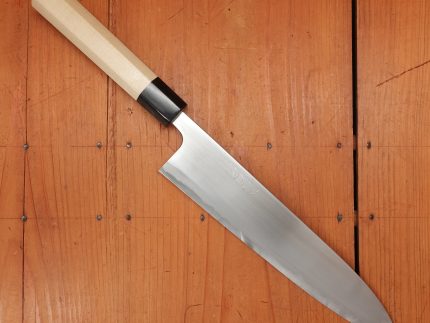This is the official buy Yoshikane Hamono 240mm Kiritsuke Gyuto SKD Nashiji Teak Handle, which is designed to be worn during any game day. You can also wear it as a casual top or a night out top. The fabric of this Yoshikane Hamono 240mm Kiritsuke Gyuto SKD Nashiji Teak Handle is 100% polyester and it is designed to be lightweight.
Shop for your Yoshikane Hamono 240mm Kiritsuke Gyuto SKD Nashiji Teak Handle at the official team store! We stock on sizes, styles and colors to meet your needs. This is the one stop shop for all your Yoshikane Hamono 240mm Kiritsuke Gyuto SKD Nashiji Teak Handle gear.
Made for Hatsukokoro by Yoshikane in Sanjo Niigata.
Yoshikane’s hand forged SKD semi-stainless core with nashiji finished stainless cladding and octagonal teak handle with horn ferrule.
SKD steel is a nearly stainless carbon steel at approx 11-12% chromium content (13% and the chromium is able to bond with itself forming a stain resistant film) it is sometimes referred to as ‘semi stainless’ as it rusts slowly and has low reactivity with flavors.
Hardened to 64 HRC, these knives hold a keen edge for a long time, owing to thier excellent heat treatment and despite this hardness they have a good degree of toughness and are very easy to sharpen. Being ground with a wide, kiriba primary bevel, they also allow for easy thinning down the road, especially as Yoshikane kireba grinds are especially flat.
The core of this knife is ‘semi-stainless’ and has a certain degree of rust resistance, but as it is not completely stainless, it should be dried immediately after use. The core will develop a patina with use, but any orange rust should be removed with a light abrasive.
Yoshikane is headed by Kazuomi Yamamoto the fourth generation to operate this family run forging and grinding operation in Sanjo, Niigata which has been making kitchen knives since 1919. They deserve their good reputation for excellent forging and heat treatments, which make for easy sharpening and great edge life for both single and double bevel knives. This is especially true about the thin grinds provided on their double bevel knives. For middleweight Japanese knives, they cut like a much thinner blade.






















